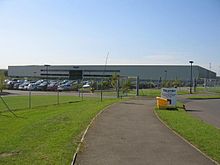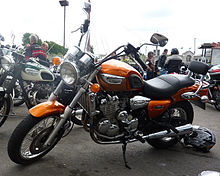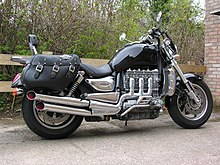Triumph Motorcycles Ltd: Difference between revisions
m Robot - Speedily moving category Triumph motorcycles to Category:Triumph Motorcycles Ltd motorcycles per CFDS. |
Cyberbot II (talk | contribs) Rescuing 1 sources, flagging 0 as dead, and archiving 17 sources. #IABot |
||
| Line 33: | Line 33: | ||
In May 2002, Triumph began construction on a new sub-assembly manufacturing facility in [[Chonburi (city)|Chonburi]], Thailand to make various components.<ref name="Thailand">[http://members.bccthai.com/BCCT/asp/corpDetail.asp?CorpID=46 Triumph Motorcycles (Thailand) Ltd., Company Details]</ref> A second factory was opened in 2006 by [[Prince Andrew, Duke of York]] where a wet painting facility and assembly line have been established.<ref name="Thailand" /><ref>{{cite web|url=http://www.fasterandfaster.net/2006/08/triumph-opens-second-plant-in-thailand.html |title=Triumph opens second plant in Thailand|accessdate=21 September 2008}}</ref> A third factory was opened in 2007 to include high pressure die-casting and machining, and Triumph announced that they were expanding to increase capacity to over 130,000 motorcycles.<ref>{{cite web|url=http://www.webbikeworld.com/triumph-motorcycles/triumph-motorcycles.htm|title=Triumph Motorcycles |accessdate=21 September 2008}}</ref> Triumph Motorcycles (Thailand) Limited is a 100% UK owned company and now employs about 1000 staff.<ref name="Thailand" /> |
In May 2002, Triumph began construction on a new sub-assembly manufacturing facility in [[Chonburi (city)|Chonburi]], Thailand to make various components.<ref name="Thailand">[http://members.bccthai.com/BCCT/asp/corpDetail.asp?CorpID=46 Triumph Motorcycles (Thailand) Ltd., Company Details]</ref> A second factory was opened in 2006 by [[Prince Andrew, Duke of York]] where a wet painting facility and assembly line have been established.<ref name="Thailand" /><ref>{{cite web|url=http://www.fasterandfaster.net/2006/08/triumph-opens-second-plant-in-thailand.html |title=Triumph opens second plant in Thailand|accessdate=21 September 2008}}</ref> A third factory was opened in 2007 to include high pressure die-casting and machining, and Triumph announced that they were expanding to increase capacity to over 130,000 motorcycles.<ref>{{cite web|url=http://www.webbikeworld.com/triumph-motorcycles/triumph-motorcycles.htm|title=Triumph Motorcycles |accessdate=21 September 2008}}</ref> Triumph Motorcycles (Thailand) Limited is a 100% UK owned company and now employs about 1000 staff.<ref name="Thailand" /> |
||
The Triumph Group announced sales of 37,400 motorcycles in the financial year ending 30 June 2006. This represented a growth of 18% over the 31,600 produced in 2005. Company turnover (revenues) rose 13% to £200 million ($370 million), but net profit remained static at around £10.3 million due to recent investment in production facilities.<ref>{{cite web |
The Triumph Group announced sales of 37,400 motorcycles in the financial year ending 30 June 2006. This represented a growth of 18% over the 31,600 produced in 2005. Company turnover (revenues) rose 13% to £200 million ($370 million), but net profit remained static at around £10.3 million due to recent investment in production facilities.<ref>{{cite web|url=http://www.webbikeworld.com/triumph-motorcycles/triumph-2006-sales.htm |title=Triumph 2006 sales |work=webBikeWorld |year=2007 |accessdate=30 January 2015 |deadurl=yes |archiveurl=https://web.archive.org/20080720095046/http://www.webbikeworld.com/triumph-motorcycles/triumph-2006-sales.htm |archivedate=20 July 2008 }}</ref> In June 2009 [[Digby Jones, Baron Jones of Birmingham]], the former Minister of State for Trade, became chairman of Triumph motorcycles (Hinckley) Ltd and the {{convert|1600|cc|cuin|abbr=on}} [[Triumph Thunderbird (2009)|Thunderbird]] twin-cylinder cruiser was announced.<ref>The [[Daily Telegraph]], 4 June 2009</ref> |
||
The Group turnover increased by 11% from £312.4 million in 2010 to £345.3 million in 2011 and unit sales of motorcycles increased by 7% from 45,501 to 48,684. This increase in unit sales can be largely attributed to the introduction of incremental models to the range. The operating profit before interest and tax grew from £15.1 million to £22.3 million due to strong sales of motorcycles and related products, benefitting from improved use of working capital and continued focus upon the cost base. During 2011 Triumph launched three new motorcycles: the Tiger Explorer, Speed Triple R and the Steve McQueen Special,<ref name="motorcycledaily.com">{{cite news | url= http://www.motorcycledaily.com/2011/12/triumph-motorcycles-group-announces-2011-financial-results/| title= Triumph sales remain strong despite industry slump | publisher=Motorcycle Daily | date= 7 December 2011| accessdate= 20 February 2012}}</ref> successfully bucking the trend of the global downturn in motorcycle sales.<ref>{{cite web|last=Duke |first=Simon |url=http://www.thisismoney.co.uk/money/markets/article-2068819/Triumph-gear-motorbike-sales-rise.html |title=Triumph in top gear as motorbike sales rise |publisher=This is Money |date=1 December 2011 |accessdate=30 January 2015}}</ref> |
The Group turnover increased by 11% from £312.4 million in 2010 to £345.3 million in 2011 and unit sales of motorcycles increased by 7% from 45,501 to 48,684. This increase in unit sales can be largely attributed to the introduction of incremental models to the range. The operating profit before interest and tax grew from £15.1 million to £22.3 million due to strong sales of motorcycles and related products, benefitting from improved use of working capital and continued focus upon the cost base. During 2011 Triumph launched three new motorcycles: the Tiger Explorer, Speed Triple R and the Steve McQueen Special,<ref name="motorcycledaily.com">{{cite news | url= http://www.motorcycledaily.com/2011/12/triumph-motorcycles-group-announces-2011-financial-results/| title= Triumph sales remain strong despite industry slump | publisher=Motorcycle Daily | date= 7 December 2011| accessdate= 20 February 2012}}</ref> successfully bucking the trend of the global downturn in motorcycle sales.<ref>{{cite web|last=Duke |first=Simon |url=http://www.thisismoney.co.uk/money/markets/article-2068819/Triumph-gear-motorbike-sales-rise.html |title=Triumph in top gear as motorbike sales rise |publisher=This is Money |date=1 December 2011 |accessdate=30 January 2015}}</ref> |
||
Revision as of 10:15, 25 January 2016
| Company type | Private |
|---|---|
| Industry | Motorcycle |
| Founded | 1984 as Bonneville Coventry Limited |
| Headquarters | , England |
Key people | John Bloor (owner) The Lord Jones of Birmingham (chairman) |
| Products | Motorcycles Clothing Accessories |
| Revenue | |
Number of employees | 1,600 (2012)[1] |
| Website | www |
Triumph Motorcycles Ltd is the largest British motorcycle manufacturer; it was established in 1984 by John Bloor after the original company Triumph Engineering went into receivership. The new company (initially Bonneville Coventry Ltd) continued Triumph's record of motorcycle production since 1902. As of mid-2012, the company produced 49,000 motorcycles and employed 1,600 staff.[1]

History

When Triumph Engineering went into receivership in 1983, John Bloor bought the name and manufacturing rights from the Official Receiver.[2] The new company's manufacturing plant and designs were outdated and unable to compete against the Japanese, so Bloor decided against relaunching Triumph immediately. Initially, production of the old Bonneville was continued under licence by Les Harris of Racing Spares, in Newton Abbot, Devon, to bridge the gap between the end of the old company and the start of the new company. For five years from 1983, about 14 were built a week in peak production. In the USA, owing to problems with liability insurance, the Harris Bonnevilles were never imported.[3]

Bloor set to work assembling the new Triumph, hiring several of the group's former designers to begin work on new models. The team visited Japan on a tour of its competitors' facilities and became determined to adopt Japanese manufacturing techniques and especially new-generation computer-controlled machinery. In 1985, Triumph purchased a first set of equipment to begin working, in secret, on its new prototype models. By 1987, the company had completed its first engine. In 1988, Bloor funded the building of a new factory at a 10-acre (40,000 m2) site in Hinckley, Leicestershire.[4] Bloor put between £70 million and £100 million into the company between purchasing the brand and breaking even in 2000.
At the same time as production capacity increased, Bloor established a new network of export distributors. He has previously created two subsidiary companies, Triumph Deutschland GmbH and Triumph France SA. In 1994, Bloor created Triumph Motorcycles America Ltd.[4]
At 21.00 hours on 15 March 2002, as the company was preparing to celebrate its 100th anniversary as a motorcycle maker, its main factory was destroyed by a fire which began at the rear of the facility. At the height of the blaze, over 100 firefighters were tackling the fire, which destroyed most of the manufacturing capacity.[5] Nevertheless, the company, which by then employed more than 650, quickly rebuilt the facility and returned to production by September that year.
In May 2002, Triumph began construction on a new sub-assembly manufacturing facility in Chonburi, Thailand to make various components.[6] A second factory was opened in 2006 by Prince Andrew, Duke of York where a wet painting facility and assembly line have been established.[6][7] A third factory was opened in 2007 to include high pressure die-casting and machining, and Triumph announced that they were expanding to increase capacity to over 130,000 motorcycles.[8] Triumph Motorcycles (Thailand) Limited is a 100% UK owned company and now employs about 1000 staff.[6]
The Triumph Group announced sales of 37,400 motorcycles in the financial year ending 30 June 2006. This represented a growth of 18% over the 31,600 produced in 2005. Company turnover (revenues) rose 13% to £200 million ($370 million), but net profit remained static at around £10.3 million due to recent investment in production facilities.[9] In June 2009 Digby Jones, Baron Jones of Birmingham, the former Minister of State for Trade, became chairman of Triumph motorcycles (Hinckley) Ltd and the 1,600 cc (98 cu in) Thunderbird twin-cylinder cruiser was announced.[10]
The Group turnover increased by 11% from £312.4 million in 2010 to £345.3 million in 2011 and unit sales of motorcycles increased by 7% from 45,501 to 48,684. This increase in unit sales can be largely attributed to the introduction of incremental models to the range. The operating profit before interest and tax grew from £15.1 million to £22.3 million due to strong sales of motorcycles and related products, benefitting from improved use of working capital and continued focus upon the cost base. During 2011 Triumph launched three new motorcycles: the Tiger Explorer, Speed Triple R and the Steve McQueen Special,[11] successfully bucking the trend of the global downturn in motorcycle sales.[12]
Model range


A range of new 750 cc and 900 cc triple-cylinder bikes and 1000 cc and 1200 cc four-cylinder bikes were launched at the September 1990 Cologne Motorcycle Show. The motorcycles used famous model names from the glory days of Meriden Triumph and were first made available to the public between March (Trophy 1200 being the first) and September 1991. All used a modular liquid-cooled DOHC engine design in a common large diameter steel backbone frame. The modular design was to ensure that a variety of models could be offered whilst keeping production costs under control—an idea originally put forward, in air-cooled form, in the early 1970s by Bert Hopwood but not implemented by the then BSA-Triumph company.
The first models, known generically as the T300s, all used a common piston diameter (76 mm) in a common wet cylinder liner. Basic engine variations were achieved through the use of two specifications of piston stroke: 65 mm to create individual cylinder capacity of 300 cc, and 55mm to create a 250 cc individual cylinder. Two 750 cc models were released - and the Daytona and Trident 750 triples (3 x 250 cc). There was one 1000 cc model - the Daytona 1000 four (4 x 250 cc). Two 900 cc models were the Trophy 900 and Trident 900 triples (3 x 300 cc). The Trophy 1200 four was the largest model (4 x 300 cc). All were remarkably smooth running. The three cylinder models were equipped with a contra-rotating balance shaft mounted at the front of the engine. The four cylinder models benefitted from twin balance shafts - unique at the time - mounted beneath the crank shaft. Contemporary road tests noted the solidity and smoothness of performance as positives but the weight of the machines as negatives. For brand new machines produced by a totally new concern, there were remarkably few early problems. These were an insecure oil pressure switch and a longer-lived problem with the starter (or sprag clutch). The cosmetic finish on the first machines was simple and not very robust. Revisions to crankcases for the three-cylinder models in 1993, together with a move to high pressure casting, reduced engine weight considerably. All painting and plating operations were brought in house in 1993, as the Hinckley factory benefitted from further investment after the initial success of the range. The result was improved quality and durability of finish, added to the basic engineering integrity of the engine and chassis, made for a long-lasting and robust motorcycle.
The range was largely revised in 1997 with the release of the T500 range, followed by a light-weight four-cylinder 600 cc sports TT600. The 600 was a major design departure and initially received a poor press: "unpleasant at low revs due to a lethargic and unpredictable throttle response, with anonymous styling".[13] As sales built, the big fours were phased out of the lineup and parallel twins and triples became the marketing and development focus of Triumph's marketing strategy. Triumph also decided to exploit demand for retro motorcycles with modern engineering. The Triumph Thunderbird 900 exploited the styling cues of the 'old' Triumph's legendary designer, Edward Turner whilst retaining the modern triple engine. The 790 and 865 cc versions of the Triumph Bonneville and Thruxton look and sound original but internally they have modern valves and counterbalance shafts.


For their contemporary range, the triple is Hinckley Triumph's trademark, filling a niche between European and American twins and four-cylinder Japanese machinery. The 2,294 cc (140.0 cu in) triple Rocket III cruiser was introduced in 2004. The first 300 Rocket III models were already sold before they were produced, and there was a long waiting list for Rockets into 2005.[14]
On 21 July 2008, Triumph held a Global Dealer Conference where new models for 2009 were launched, including the official announcement of the parallel twin-cylinder Thunderbird.[15]
Triumph's best selling bike is the 675 cc Street Triple. In 2010 they launched the Triumph Tiger 800 and Tiger 800 XC, dual-sport motorcycles, which uses an 800 cc engine derived from the Street Triple, and is designed to compete directly with the market leading BMW F800GS.[16] In 2012, the Tiger 800 was joined by the shaft-driven Triumph Tiger Explorer.
Triple Connection & celebrity marketing

In 1995, the Triple Connection clothing range and the accessories range of products were launched.[4] Triumph made a commercial decision to design all their own motorcycle clothing rather than license other producers.[17] In the 21st century, Triumph marketed lines of clothing highlighting their association with celebrities strongly associated with the old Triumph marque such as Marlon Brando,[18] Bob Dylan, James Dean,[19] Elvis Presley[20] and particularly, Steve McQueen, for whom the company named a special edition of their Bonneville motorcycle.[21]
See also
Sources
- ^ a b c d Ruddick, Graham (15 November 2012). "Triumph Motorcycles profits slow amid eurozone uncertainty". The Daily Telegraph. Retrieved 26 January 2013.
- ^ "1980's - The end and the new beginning". Retrieved 20 September 2008.
- ^ "New Triumph Co. Ltd. History". Retrieved 21 September 2008.
- ^ a b c "Rebuilding the Marque". Retrieved 21 September 2008.
- ^ "Fire sweeps through motorcycle plant". BBC News. 16 March 2002. Retrieved 21 September 2008.
- ^ a b c Triumph Motorcycles (Thailand) Ltd., Company Details
- ^ "Triumph opens second plant in Thailand". Retrieved 21 September 2008.
- ^ "Triumph Motorcycles". Retrieved 21 September 2008.
- ^ "Triumph 2006 sales". webBikeWorld. 2007. Archived from the original on 20 July 2008. Retrieved 30 January 2015.
{{cite web}}: Unknown parameter|deadurl=ignored (|url-status=suggested) (help) - ^ The Daily Telegraph, 4 June 2009
- ^ "Triumph sales remain strong despite industry slump". Motorcycle Daily. 7 December 2011. Retrieved 20 February 2012.
- ^ Duke, Simon (1 December 2011). "Triumph in top gear as motorbike sales rise". This is Money. Retrieved 30 January 2015.
- ^ "Triumph's secret weapon". The Daily Telegraph. London. Retrieved 21 September 2008.
- ^ Garrett, Jerry. "Triumph's Rocket III more than lives up to its ballistic name". Retrieved 21 September 2008.
- ^ "Triumph News". Retrieved 21 September 2008.
- ^ "Triumph Tiger 800 launch: Simon Warburton". Visordown. 7 November 2010. Retrieved 23 November 2010.
- ^ "Triple connection" (PDF). Retrieved 21 September 2008.
- ^ "Marlon Brando Lands Motorcycle Marketing Deal from Bikes in the Fast Lane". Daily Motorcycle News. 13 November 2009. Retrieved 30 January 2015.
- ^ "James Dean". CMG Worldwide. 2014. Retrieved 30 January 2015.
- ^ "New Triumph gear, accessories include Elvis jacket, Kriega bags". Dealer News. 15 March 2013. Retrieved 30 January 2015.
- ^ West, Phil (24 October 2011). "New Triumph 'Steve McQueen edition' debuts". Motor Cycle News. Retrieved 30 January 2015.
- "Triumph Motorcycles Group Announce 2010 Financial Results". docstoc.com. 2015. Retrieved 30 January 2015.
